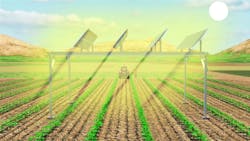University of Delaware Contracts SolAgra for 2 Agrivoltaic Solar Arrays on Campuses
The University of Delaware (UDel) has contracted SolAgra to build two agrivoltaic solar arrays on its Newark and Georgetown campuses to study solar power and crop production on farmland.
The projects, which will launch in time for the 2024 growing season, will allow faculty and students in the College of Agriculture and Natural Resources to study the benefits of co-locating solar tracking systems with crop production.
The test crops will consist of fruits and vegetables currently being impacted by adverse climate change-related weather, and demonstrating the mutual benefits is expected to provide more information on using agricultural land for large-scale dual-use PV installations.
“Two of the greatest challenges for the future are providing clean energy and food in a changing climate. It makes sense to find a common solution," said Co-PI Dr. Steven Hegedus, Professor of Electrical and Computer Engineering and Senior Scientist at UDel's Institute of Energy Conversion. "Our research will show how they can support each other. Farmers can supplement their crop income with electricity sales and the solar modules will also protect the crops from intense heat and rain."
SolAgra’s elevated solar arrays will produce green energy on farmland while sustaining or improving the quality of the crops growing beneath them. The arrays’ design also allows for multiple configurations for a variety of crops, and the structure can be moved to control where the sunlight and shade are landing on the field, allowing farmers to regulate how much shade crops receive while maintaining solar power production.
SolAgra pays participating farmers for the use of the “air rights” above their farmland by sharing a portion of the power sales revenue. The farmers also experience the protective benefits of the solar arrays, which shield crops from excess sunlight, rain, and hail, which can damage crops and lead to a loss in profit.
About the Author
Breanna Sandridge, Senior Editor
Breanna Sandridge is senior editor for EnergyTech and Microgrid Knowledge, both part of the energy group at Endeavor Business Media.
Prior to that, Breanna was managing editor for Machinery Lubrication and Reliable Plant magazines, both part of Noria Corp. She has two years experience covering the industrial sector.
She also is a 2021 graduate of Northeastern State University (Oklahoma) with a Bachelor's in English.
